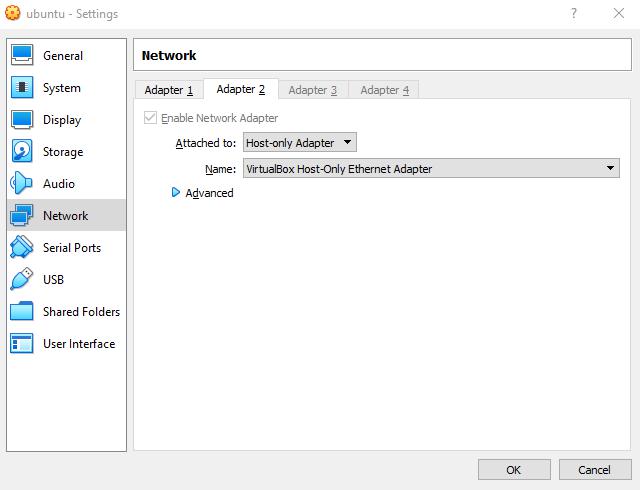Here is how to work with Linux inside a virtual machine from Windows using ssh client and VirtualBox. If you will use any command line ssh client you could use all Linux functions right inside your standard Windows Command Line
0 Setup Software to the Host
Set up VirtualBox, VirtualBox Extension and Ubuntu Server Edition (or Ubuntu Desktop) in a regular mode. I called the machine just: “ubuntu”
1 Add VirtualBox setup directory to the PATH variable
setx /M path "%path%;"C:\Program Files\Oracle\VirtualBox\""
Note: C:\Program Files\Oracle\VirtualBox\ could be differs
2 Set up a VM network
Virtual Machine Settings -> Network -> Adapter 2 (tab) -> Attached to: -> Host-only adapter-> OK (button).

3 Setup ssh server on the Ubuntu VM
Run the virtual machine
Open a Linux terminal and write:
sudo apt-get install openssh-server nano net-tools
(Optional) Config the SSH server
In a Linux terminal (guest ubuntu):
sudo nano /etc/ssh/sshd_config
And restart SSH server:
sudo systemctl restart ssh.service
(Optional) Set up a non-gui mode
If you set up Ubuntu Desktop you could turn off GUI at startup to reduce the resource consumption. Even more it is not needed working through a console. In a guest terminal:
sudo systemctl set-default multi-user.target
To turn on GUI again use:
sudo systemctl set-default graphical.target
4 Check your local VM IP
ifconfig
It should be something like 192.168.56.101, in my case, at least
5 Close the Virtual Machine
Do it.
6 Run VMbox from CMD
VBoxManage startvm "ubuntu" --type headless
Instead “ubuntu” you should use your VM name
7 Connect to Ubuntu via any SSH client
For example, right from Command Line via ssh from cygwin:
ssh user@192.168.56.101
Note: change user to your username in guest’s VM and 192.168.56.101to IP which we checked on the 4th step
8 Use it!
For example like there: https://docs.espressif.com/projects/esp-idf/en/latest/get-started/linux-setup.html
(Optional) Connect USB device to your working VM
In the host cmd get the list of devices:
VBoxManage list usbhost
Connect via UUID:
VBoxManage controlvm ubuntu usbattach f8a9f295-e221-49b0-97a5-aec55d6a2c8c
9 Stutdown** **VMbox when you’ve done
VBoxManage controlvm "ubuntu" poweroff --type headless
(Optional) Mount Ubuntu Home as a drive
A. Install SSHFS-Win
B. Open File Explorer -> right-click on This PC -> Map network drive -> in the Folder field:
\\sshfs\remoteUser@remoteIP
(Optional) Set up a shared folder
A. Inside the host:
A1. VBoxManage sharedfolder add ubuntu --name esp-repos -automount -hostpath C:\esp\repos
B. Inside the guest:
B1.
B2. Insert:
| |
B3. Register start script: